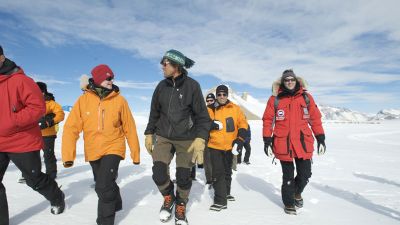
Live from Antarctica: Monday 16 February
Sleepless in the Sor Rondanes, we have been for several nights now. Some of us more than others, but all of us are running on large doses of adrenalin.
The work on the station intensified in the last week before the inauguration, reaching a crescendo with a last paroxysmal burst of activity to prepare the station and receive the honoured guests.
A bunch of strategic cables to place, solar panels to put up, connections to essential ventilation units to be made, tests to run and the microgrid to initiate. Everyone pitches in, scientists, technicians, mechanics, builders and carpenters: we evacuate the scaffolding, clean and dust, fix handles, bring in the furniture, hang the pictures and we're ready to roll at past three o'clock on a cold and frosty morning. The first plane is due in at seven.
The feverish preparations extend to all: Greg and David begin cooking up a storm a few days in advance, with Nathalie, Illir and Seb as assistants, Jacques B prepares the station rooms to take on the 30 odd occupants expected, René puts up another 20 tents with his little band of dedicated helpers, Jack T lays down a large stock of snow blocks for the snow melters. Frank and Oli G prepare the fuel for the planes.
A couple of hours of sleep and we're up again. The internet is down so we need to contact Novo by phone to find out the time the first plane will leave, at around 5.00 am GMT.
The sky is clean and crisp blue, the sun warm despite the biting cold. We are amazed by our good fortune. The small dots on the horizon resolve themselves into mosquitoes and then they are all landing, Lidia and Polar 5 first. John, pilot of the Lidia, does a low pass over the station for the benefit of our VIPs. The last to arrive is the De Havilland Twin Otter. We all look on with interest as it lands. Our very first Twin Otter.
The planes begin to disgorge their passengers and we edge forward to meet them not quite sure what to expect. Everyone is laughing and talking at once. The Ministers Pieter De Crem and Sabine Laruelle descend from the plane into the blinding sunlight. Formality cannot last long in this place far removed from the ordinary thoroughfares of the cities of the World. The excitement is infectious, and, misjudging the distance, the first guests enthusiastically head off on foot to the station. The old hands smile as they race past on their skidoos or trundle past on their tractors and head for the warmth of the mess tent for breakfast and to await their arrival.
The guests are registered, allocated their rooms, and their guides, and then begin the activities. With several camera crews in tow we head for the first stop on the ridge, Science Platform North, which Alain, François and I built.
Nicholas Bergeot from the Observatoire introduces his instruments (GPS and relative gravimeter) to the guests. An automatic weather station, Alex and his remarkable aethalometer and one CIMEL sunphotometer (gazing in admiration at the azure skies) later, and we are all gathered on the roof of the station for the big moment, out of breath and shivering slightly, from the thin air, the cold and the excitement of the moment.
Alain, Minister Laruelle and Minister De Crem stress once again the amazing nature of the project, but they are preaching to the converted. Everyone standing in front of them is convinced of the wondrous nature of what is about to open up before them, even the most hard-bitten journalists are shaken in their certainties. The plaques are unveiled and the photos follow. We are too slow, the champagne is beginning to freeze in the glasses.
Through the red door, the same door that Prince Philippe opened in Brussels, we begin the guided tours, but these soon fall apart as each visitor hones in on the thing that interests them most.
Our resident scientists, Jeroen and Karolien from Ghent, Steve from BAS, Cyrille from the Natural History Musuem in Paris, Annick from the University of Liège, Alexander and Nicholas from the Royal Meteorological Institute in Brussels, and Irina from the LGGE in Grenoble, explain their activities during the season to a captivated audience.
The technical teams explain how different bits function: the PLC, the water treatment units, the ventilation, the prototype power grid reuniting the solar and wind converters and batteries into a stable supply of energy.
The visitors admire everything: the station, the landscape, us, even the Philippe Starck toilets courtesy of Facq. Our scientists are going to be really coveted it seems. The idea that ecological living had to be Spartan has suddenly come up against the reality of a building that is intelligent and does not damage its surroundings. A building that gladdens the eye and excites the mind. Finally, we have taken a step towards a World that could become reality with partners from industry who have demonstrated that an alternative future is not only possible, but is happening. We only have to ask for it.
Our Inauguration Banquet started with an video-recorded address by T.R.H. Prince Philippe and daughter Princess Elisabeth of Belgium to Alain Hubert, IPF and all project participants. The dinner was equally a feast for the eyes, the mind, the palate and the soul. Another short night ahead for the intrepid souls who sail in the space-ship Princess Elisabeth across the frozen seas of this strange continent. The Trekkies come out of the closet, and I can swear I can hear the harsh consonants of Klingon being uttered in the half light of an Antarctic night.
Nighat Amin
Picture: Arrival of VIPs at Utsteinen - © International Polar Foundation
